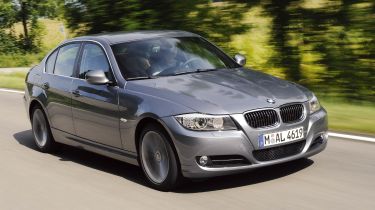BMW 330d saloon
Class leader benefits from raft of upgrades as it bids to keep ahead of new competitors.

The subtle tweaks BMW has made to the 3-Series are certain to broaden its appeal, and will ensure it remains in contention for honours in the compact executive class. Thanks to its well judged makeover, the new 3 blends even greater style and practicality with cutting-edge technology. The improved functionality of the iDrive cabin control system and the enhanced EfficientDynamics package are particularly welcome.
It’s no secret that the 3-Series is BMW’s most important car. Around 32,000 saloon and Touring models are bought
here each year, which puts the model ahead of the Ford Mondeo in the sales charts.
But with increasing competition, led by the Audi A4, the 3-Series is under pressure, so it has gone under the knife to ensure it stays ahead of the game.
The success of the existing model means styling tweaks have been kept to a minimum. Still, the company’s designers have been hard at work improving the facelifted car.
The car is wider to provide greater stability and even better handling, while the front bumper now features more sculpted, upturned air intakes. These draw attention to the greater girth, and a big, horizontal band does the same job on the rear bumper.
There’s also a new bonnet, which has two sharp lines running from the badge to the hood’s trailing edge. And the side sills are sharply creased, giving the impression that the 3-Series is longer than before.
Used - available now

2022 BMW
3 Series
27,928 milesAutomaticPetrol2.0L
Cash £22,900
2020 BMW
3 Series
46,386 milesAutomaticPetrol2.0L
Cash £19,600
2022 BMW
3 Series
22,598 milesAutomaticPetrol2.0L
Cash £23,100
2022 BMW
3 Series
60,000 milesAutomaticPetrol2.0L
Cash £17,700There are new light clusters, too. Up front are twin-halo daytime running lamps that mirror those seen on the larger 5-Series. Both front and rear clusters also benefit from LED indicators, which are brighter and more attractive.
Inside, it’s a similar story of refining the package. The cabin is more practical, while new materials improve the air of quality. But the biggest change is to the much-maligned iDrive control system. The new set-up uses a hard drive, rather than being DVD-based, so it works much faster. Plus, the controller is upgraded, while the screen is now bigger and more colourful.
A number of useful functions have been added, such as the ability to save your MP3 digital music files on to the
system and the optional ConnectedDrive Internet access. The 3D sat-nav works well, too. But best of all, iDrive is more intuitive, so it’s nowhere near as frustrating to master as it once was.
We drove the 330d, which has an all-new version of the six-cylinder 3.0-litre turbodiesel. This engine is 5kg lighter than before, and although it delivers an extra 14bhp and 20Nm of torque – at 245bhp and 520Nm respectively – it’s seven per cent more fuel efficient. That means it returns 49.6mpg combined, thanks in part to the improved EfficientDynamics system, which includes stop-start technology.
On the road, the powerplant is fairly vocal, and while it’s not as tuneful as the 3.0-litre petrol, it sounds pleasant. It certainly has plenty of power, with the traction control being triggered under modest acceleration on damp roads. Most impressive is the unit’s flexibility at any speed, making town driving as effortless as overtaking on the motorway.
The steering is lighter, but still direct, and the wider track means handling remains strong. So the tweaks keep the 3-Series at the top of the tree for drivers wanting practicality and pace, especially with this impressive new diesel. But bosses predict the 320d, which has an equally strong engine at a lower price, will account for half of all sales.
Rival: Audi A4
Our current compact executive champ is typically understated inside and out, comes with punchy petrol and diesel engines and generous standard kit. Yet while Audi’s engineers have improved the car’s dynamics, it still can’t quite live up to the 3-Series along a twisting road.







